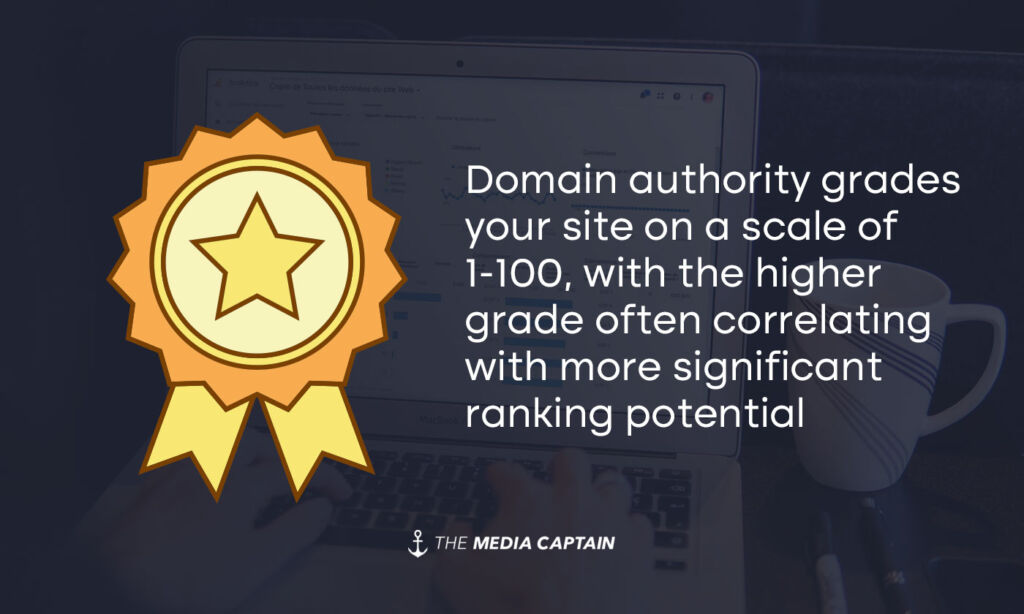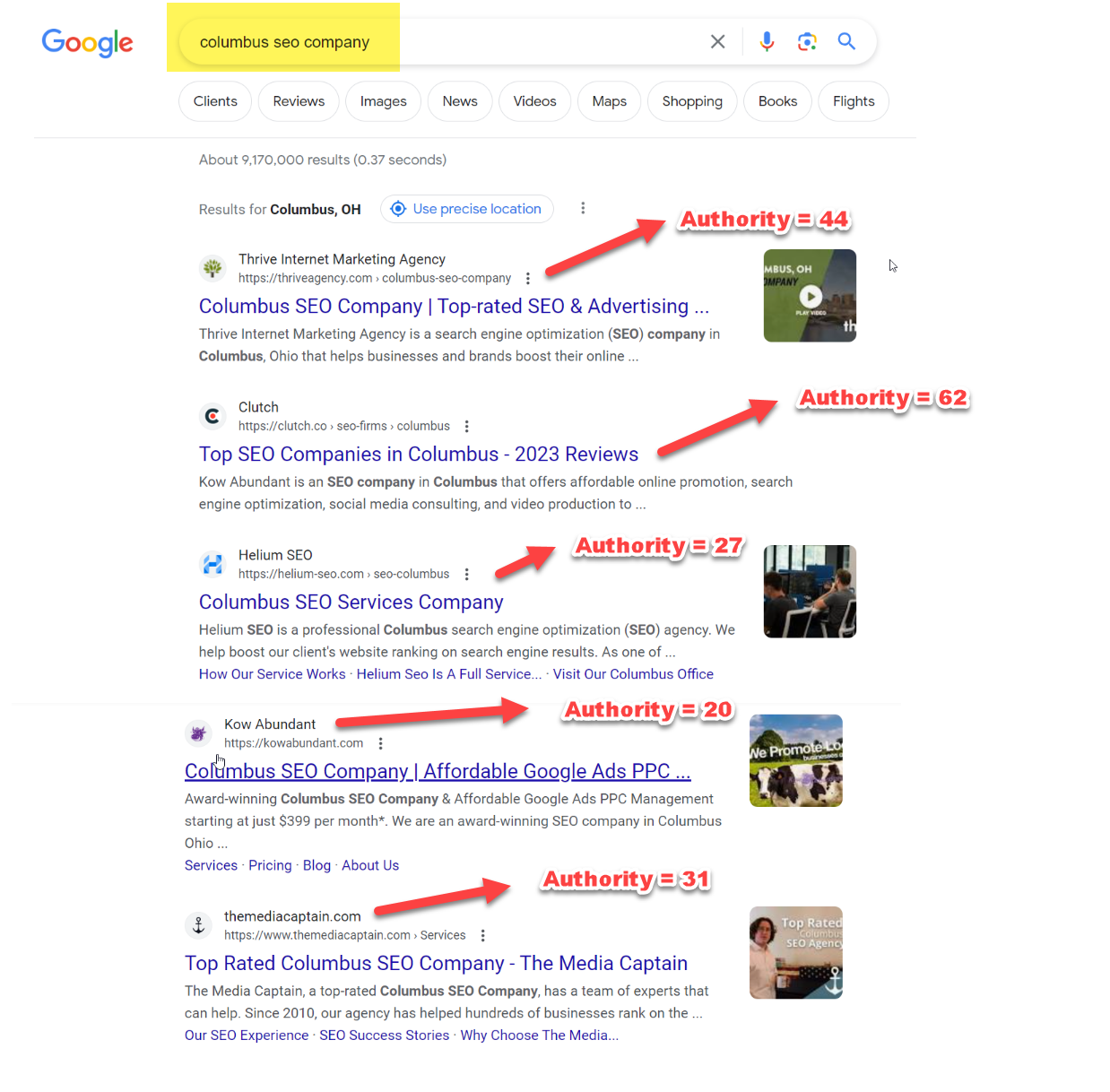- Domain Authority (DA) is a search engine ranking score developed by Moz that predicts how likely a website will rank in search engine result pages (SERPs).
- Domain Authority was launched by Moz shortly after its inception in 2004.
- Domain authority grades your site on a scale of 1-100, with the higher grade often correlating with more significant ranking potential. You can measure your site versus competitors to see how your authority stacks up.
- External backlinks pointing to your site are how the domain authority score is calculated.
- Domain authority has no bearing on your actual Google rank. It’s only a comparison tool that predicts how Google would rank a website.
- Since Moz launched domain authority, many competitors have launched similar versions, including SEMRush’s Domain Overview, Majestic’s Trust Flow, and Ahref’s Authority Checker.
- Authority Score is SEMRush’s terminology for predicting how well a website will rank on Google.
- When auditing your website’s authority, take the score with a grain of salt. Low-quality links could artificially inflate your score.
I want to reiterate that domain authority is not a Google ranking factor. When people ask about increasing their domain authority, most of the time they wonder how to build more backlinks to increas website authority to improve SEO.
Backlinks are especially valuable for SEO because they represent a “vote of confidence” from one site to another [source]. The more quality backlinks you get, your site will be more authoritative over time. I wrote a detailed blog about how to acquire high-quality links for SEO. Please read this blog if you want your website to become more authoritative.
Related Blog: How long does your website take to rank on Google?
In 2019, our agency launched an eCommerce skincare brand, Park Perfection. When you look at the referring domains, there were zero when we started. Fast forward to 2023, we now have 133 referring domains from authoritative sites. This increased our authority score from a 0 to an 18, which SEMRush grades as “Average.”
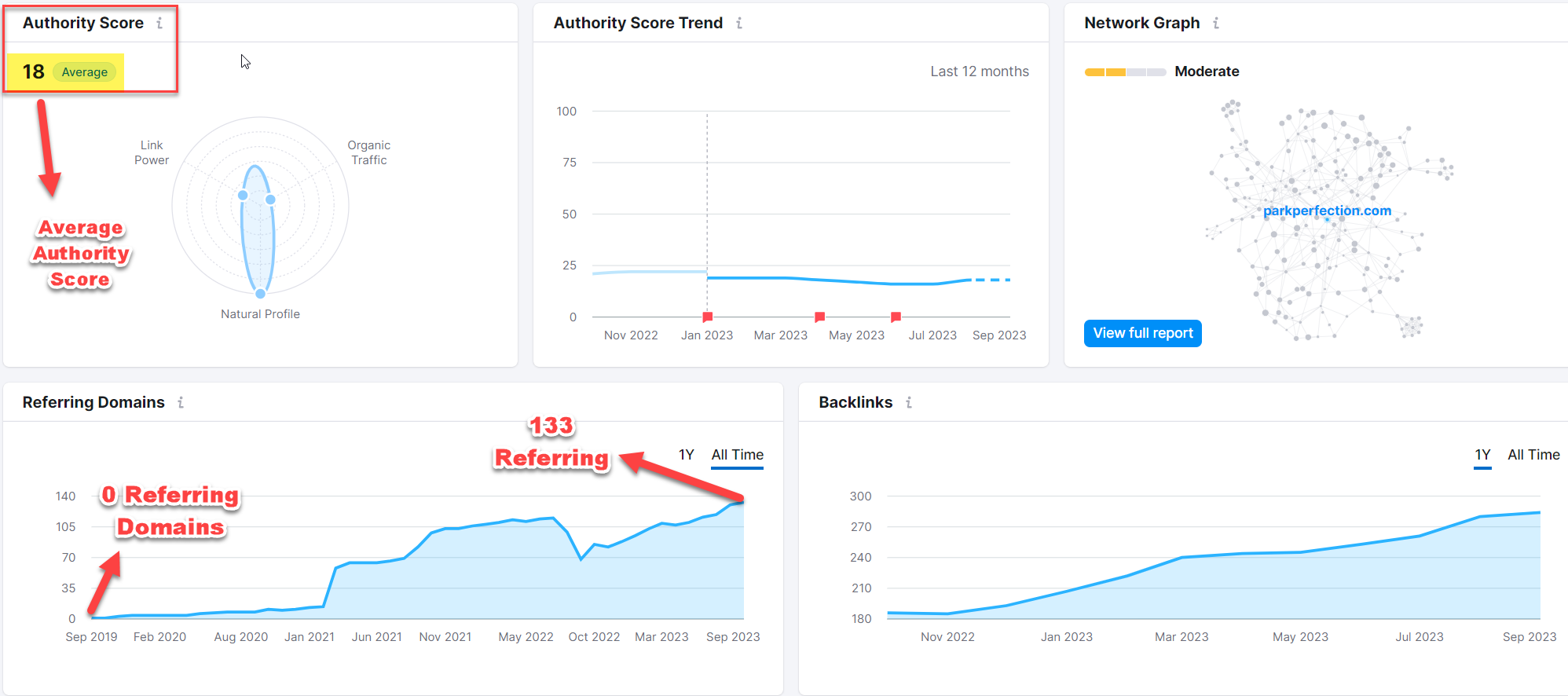
If you were to analyze all of the sites on the first page of Google for a specific query and then look at the authority score, there is a strong correlation between rank and authority score.
This isn’t always the case, though. A site with a lower authority score can have much better content and substance, helping it outrank a more competitive site with a higher authority score. ‘
Below are the top 5 results on Google for “Columbus SEO Company.” You will see all businesses ranking in the top 5, along with their authority score. Although not perfect, there is a strong correlation between rank and authority score.
Quality Backlinks
Google is good at identifying low-quality links, which get discounted and can cause more harm than good. To positively grow your authority, you want to get quality links.
Sticking with the Park Perfection example, you can see that high-quality links with strong authority scores link back to Park Perfection’s site, which, over time, has increased domain authority/authority score.
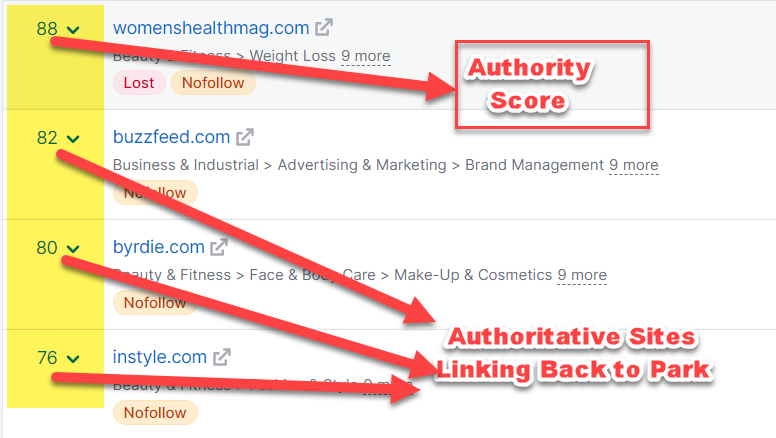
People get discouraged when first learning about and seeing their domain authority. They view the score as similar to a test score in school. If someone were to get below 60%, this would be a failing grade. This isn’t how the authority score works. When you get above a score of 10, this is decent. Below is how our agency analyzes overall authority.
- 0-10
- This grade is below average.
- This means your site is relatively new or doesn’t have much authority.
- You can rank well if you’re going after niche, non-competitive queries.
- There’s a lot of room to improve your domain authority, which can improve your Google rankings!
- 11-20
- 11-20 is average.
- This means you have a decent foundation of links pointing back to your site.
- There’s potential to start ranking for localized keywords and niche blog posts, amongst other queries.
- You will still have a tough time ranking for competitive queries.
- When we see a local business ranking in the 11-20, we know there’s an opportunity!
- 21-30
- 21-30 is good.
- This means you have a well-rounded backlink profile!
- You can start ranking well for many queries, especially local and blog posts.
- You still may find it challenging to rank for competitive or more national-based queries.
- 31-40
- 31-40 is very good.
- This means you have credible backlinks coming in from authoritative sites.
- You can start ranking well for national queries and more competitive terms.
- At this point, it becomes much more challenging to increase authority.
- 41-50
- 41-50 is excellent.
- You have consistent, relevant backlinks from authoritative and likely well-known sites.
- You should be ranking for many keywords that you’re looking to target, likely on a national scale.
- 51+
- 51+ is superb.
- You likely have an extremely powerful site, ranking for many queries, with quality links pointing to your site.
- Most local businesses do not have an authority score above 50. This would most likely be a business with a national presence.
Below is how each of the different sites refer to their domain authority name:
- Moz: Domain Authority
- SEMRush: Authority Scor
- Majestic: Trust Flow
- Ahref’s: Authority Checker
Our agency uses SEMRush mainly because we use SEMRush for keyword tracking, scheduling our social posts, and more. I love the authority score checker within SEMRush since it allows me to easily audit the backlink profile and look at the organic keywords already ranking for a domain when looking into the authority score.
If you are looking for an in-depth analysis of the pricing of each software solely for the purpose of domain authority, I recommend reading the Link Doctor’s comparison blog.
Different Grades for Each Site
As each site refers to the domain authority name differently, the authority grades come back nonidentical since various calculations occur.
I added our agency, The Media Captain’s domain, into each software. Below is the grade it returned for my domain. I also outlined how often you can use their authority checker before getting charged or signing up for an account.
Moz
- Moz has a 30-day free trial.
- You can use the free domain authority checker 3-times per day.
- Their lightest package starts at $99/month.
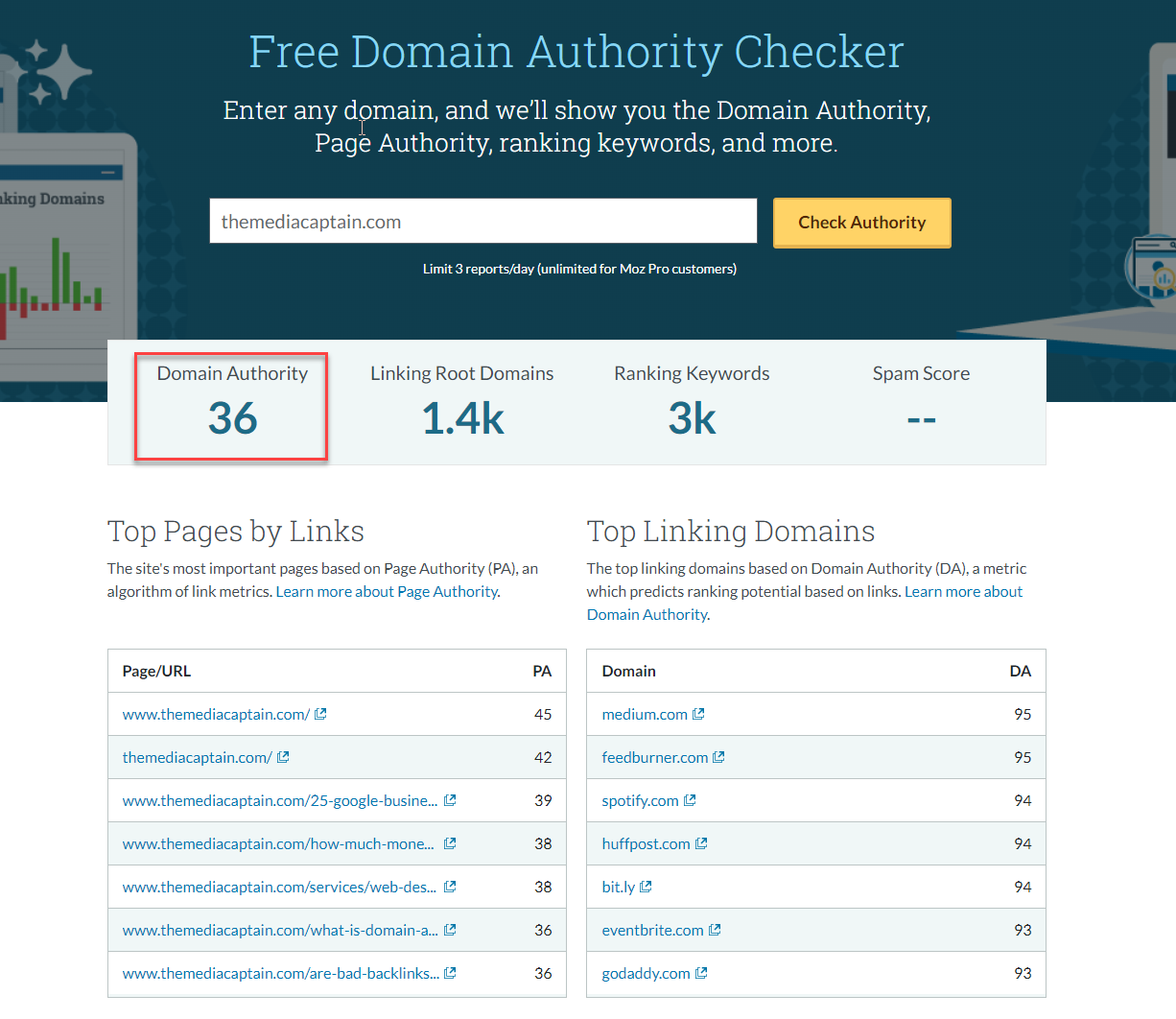
SEMRush
- SEMRush has a 7-day free trial.
- 10 free requests per day to use their Authority Checker.
- Their lightest package is $119.95/month.
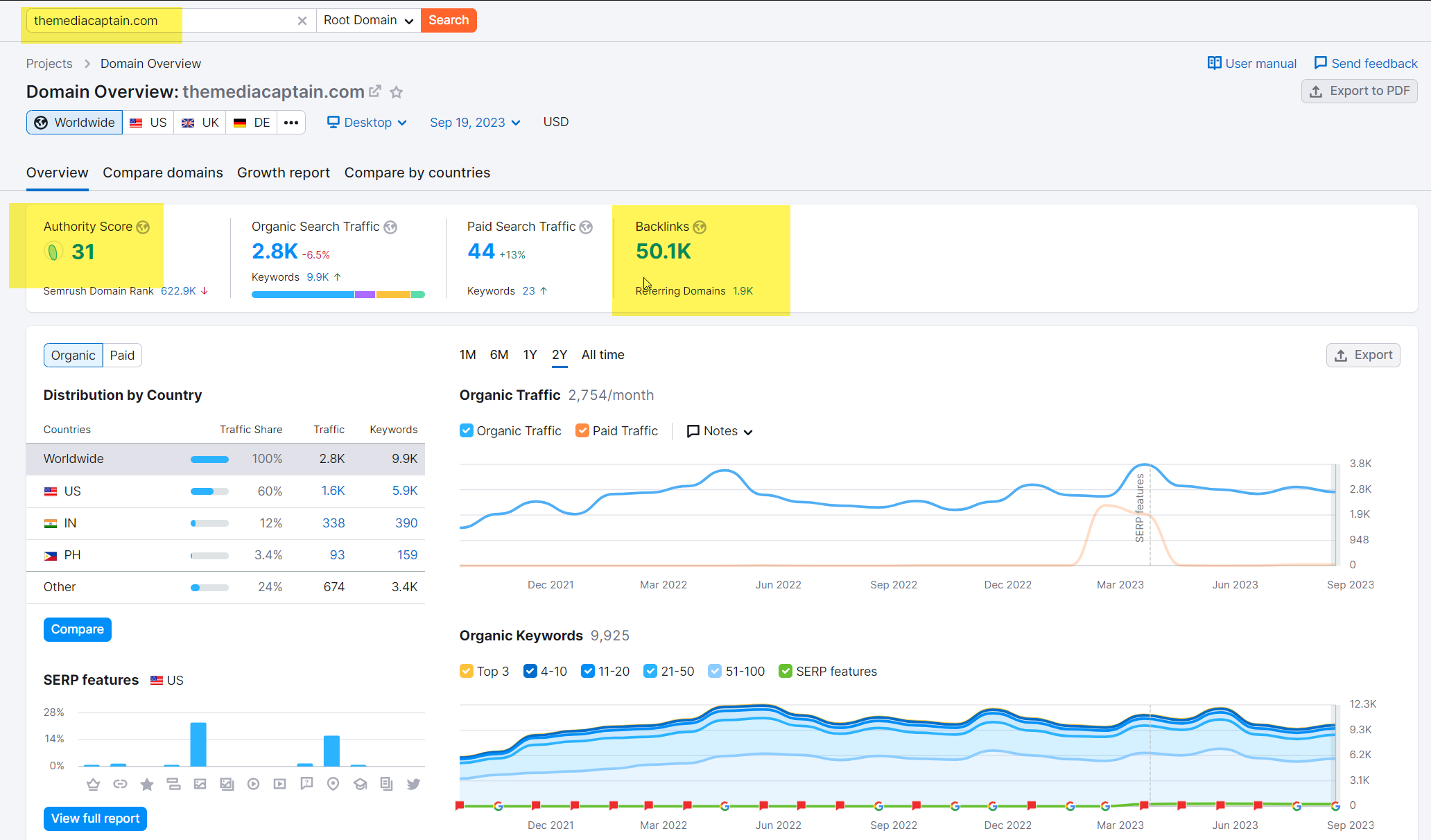
Ahrefs
- 2 months free with an Annual subscription.
- You can use their authority checker as much as you want. The issue is outside of the score they provide; there’s no other data to analyze.
- Their lightest package is $99/month.

Majestic
- Sign Up for free and get an overview of the Site Explorer feature.
- Their lightest package is $49/month.

In Closing
- Domain authority is a fantastic tool for measuring your site’s overall authority versus competitors, predicated on backlinks.
- Although domain authority isn’t a ranking factor, it’s a good indicator of how well your site will rank on Google.
- Moz was the originator of domain authority, but other great alternatives are available, like SEMRush’s authority score.
- Don’t be discouraged by a low authority score. There are plenty of opportunities to rank well with low authority sites, and there’s room for improvement to increase domain authority.
I encourage you to learn more about our SEO services, and if you would like any support, you can contact The Media Captain!



